Definition
The Plant Stress Hypothesis generally states that plants subjected to stressful conditions become more susceptible to attack by insects and diseases. This is often thought to be due to the plant’s increased suitability as a food or due to the reduced ability of the stressed plant to defend itself. It is commonly believed that when a plant is stressed it becomes better food for “bugs.” Is it correct to state that plant stress leads to pest outbreaks, or is the statement too simplistic?
The Experiments
A publication written in 1998 (Koricheva et. al.) summarized approximately 70 controlled experiments that were performed to study how distinct types of plant stresses affected insect/mite attacks. Diverse types of environmental stresses were included in these studies (e.g., drought stress, waterlogged roots, ozone exposure, excess shade, as well as many others). Plant nutrient stress & insect impacts has been researched but was not performed within these studies.
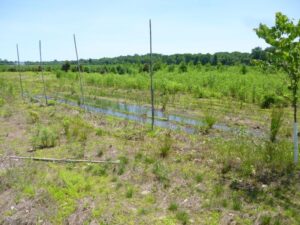
Plant roots stressed from waterlogged soils were included in these studies. Research also included other types of environmental stresses such as excess shade & ozone exposure. (Photo Credit: Steven K. Rettke, Rutgers Coop. Ext.)
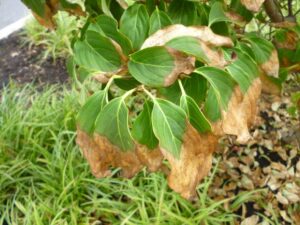
Dogwood leaves scorched from environmental drought stress. How does this plant stress impact insect herbivores? (Photo Credit: Steven K. Rettke, Rutgers Coop. Ext.)
Insects were classified how they consumed plants to organize the research data (e.g., chewers, suckers, miners, gallers and borers). In fact, organizing the insect herbivores into these guilds was the only way the data made sense (a guild is a collection of things that do something the same way).
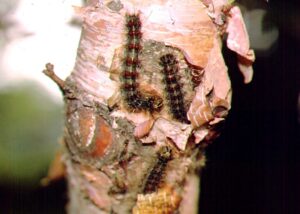
The spongy moth (formerly gypsy moth) caterpillars are representative of the insect guild called chewers. (Photo Credit: Steven K. Rettke, Rutgers Coop. Ext.)
The researchers analyzed four attributes that are important to the well being of insects and mites (as well as all living organisms) and they included (1) growth, (2) fecundity or reproduction, (3) survival and (4) attraction or colonization. The included chart below shows the Effects of Plant Stress on Insect History Traits & consists of positive (+), negative (-), no difference (0), and data insufficient (x) symbols that represents a simplification of a complex statistical analysis of how insect guilds and well-being traits interact when stressed plants are fed upon.
| GUILDS | Chewers | Suckers | Miners | Gallers | Borers |
| TRAITS | |||||
| Growth | 0 | + | x | x | x |
| Fecundity | – | + | 0 | x | x |
| Survival | 0 | 0 | 0 | – | x |
| Attraction | 0 | 0 | 0 | – | ++ |
Overview of the Results
For chewing insects (e.g., caterpillars, sawflies, leaf-feeding beetles), the study of the various stresses placed upon plants did not indicate any consistent increase or decrease in insect growth, survival, or colonization rates. However, there was a consistent decrease in reproduction when chewing insects fed upon stressed plants. In other words, plants became poorer food when chewing insects fed on stressed plants and then attempted to reproduce.
For sucking type insects/mites (e.g., aphids, scales, adelgids, and mites), plants under stress proved to provide better food for their abilities to grow (i.e., improved rate of development) and for the improved ability to reproduce by laying eggs. Therefore, stressed plants are a benefit to this guild of insects/mites (suckers) with regard to growth & reproduction.
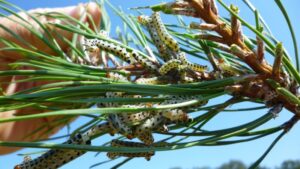
Red-headed pine sawflies feeding on Japanese black pine needles are another member of the chewing guild, similar to caterpillars & leaf feeding beetles. (Photo Credit: Steven K. Rettke, Rutgers Coop. Ext.)
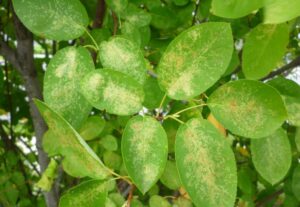
Leaf stippling symptoms on Amelanchier leaves caused from hawthorn lace bugs. They are included within the suckers guild as are mites, aphids & scales. (Photo Credit: Steven K. Rettke, Rutgers Coop. Ext.)
The leaf mining insects (e.g., birch, holly, and boxwood leafminers) were shown to be unaffected by stressed plants. No differences with rates of growth, reproduction, survival, or colonization were observed where leafminers fed upon various types of stressed plants.
The galling type insects/mites that produce abnormal growth on leaves and stems (e.g., spruce galls, oak galls, various leaf galls) were negatively affected when they fed upon stressed plants. Both survival and colonization rates decreased where gallers fed upon stressed plants.
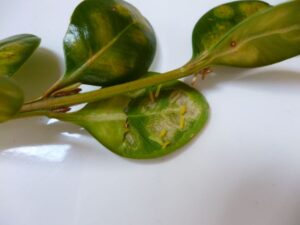
Boxwood leaf miners are members of the miners guild & also include birch leaf miners & holly leaf miners, as well as others. (Photo Credit: Steven K. Rettke, Rutgers Coop. Ext.)
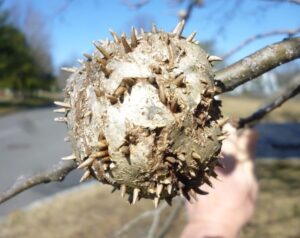
The horned oak gall is similar to the gouty oak gall & both can kill tree branches. They are both representative of the gallers guild of insect/mites. (Photo Credit: Steven K. Rettke, Rutgers Coop. Ext.)
Along with the suckers, the other big winners within the plant stress hypothesis study were the borers. Observations showed that the colonization rate of boring type insects (e.g., bronze birch borer, chestnut borer, bark beetle, clearwing moth) increased when plants were stressed. This result is very consistent with general practical landscape observations.
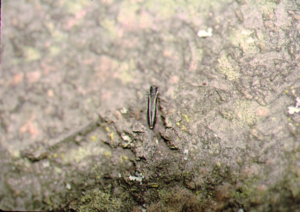
The two-lined chestnut borer is within the borers guild. When oak trees are severely stressed from spongy moth infestations, then these wood borers can create extensive vascular tissue damage & cause tree fatalities. (Photo Credit: Steven K. Rettke, Rutgers Coop. Ext.)
Specific Plant and Stress Type Results
The general result of the research was broken down further and divided into coniferous and deciduous plants. With conifers, the studies indicated that both the sucker and borer guilds increased their reproduction and colonization rates on stressed plants. Stressed deciduous plants showed that borers increased their colonization rates.
The diverse types of environmental stresses were also found to impact the insect guilds in separate ways. The research showed that shading benefited chewing insects in terms of their growth rates. Gypsy moths and tent caterpillars, for example, will benefit from plants under shade stress. Alternatively, pollution will negatively affect chewers, whereas suckers will be positively affected. Furthermore, when plants are under water stress, the chewers’ reproductive abilities were negatively affected, but the suckers’ reproduction rates increased. Hence, these research examples have indicated that the plant stress hypothesis can be complex, and simple answers are usually not appropriate. The various possible interactions can become complicated and confusing.
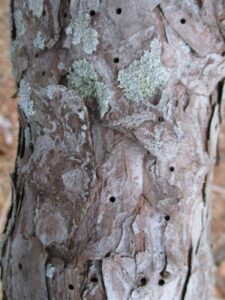
Pine bark beetle borers feeding on stressed conifers will have increased reproduction & colonization rates. (Photo Credit: Steven K. Rettke, Rutgers Coop. Ext.)
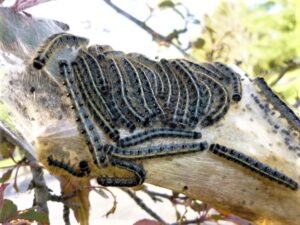
The research showed that shading benefited chewing insects in terms of their growth rates. Therefore, these Eastern tent caterpillars will benefit when feeding on plants under shade stress. (Photo Credit: Steven K. Rettkie, Rutgers Coop. Ext.)
Mature vs. Younger Trees
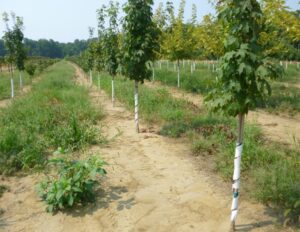
The research has shown that stressed younger trees (such as those found in a nursery), will have greater vulnerabilities to chewing insects than stressed mature trees. (Photo Credit: Steven K. Rettke, Rutgers Coop. Ext.)
Studies also showed differences in insect/mite effects when plants under stress are in various growth stages (e.g., mature plants, saplings, and seedlings). Research showed the chewers’ reproductive rates were reduced more on stressed mature trees compared to saplings or seedlings under stress. Therefore, when mature trees were stressed, they became poorer quality food for chewing insects than were saplings or seedlings that were under stress. As a result, stressed younger trees have greater vulnerabilities to chewing insects than stressed mature trees. Furthermore, the sucker guild reproduction rates were shown to increase on stressed saplings, but not on stressed mature trees. Again, the research results indicate that stressed mature trees can better withstand an assault from suckers than can younger trees. The scenario changes when boring insects and stressed mature trees are considered. Colonization was enhanced on stressed mature trees but was not enhanced on younger saplings.
Growth Rates
Insects/mites were also affected differently when stressed plants have various growth rates (i.e., rapid growing vs. slow growing plants). Overall, insect/mite survival rates were reduced on slow-growing plants under stress but enhanced on fast-growing plants under stress. In other words, plants growing slowly will be able to withstand stress from insects/mites better than plants that are growing quickly.

Insects & mites will have greater survival rates feeding on fast growing plants under stress. The maple spider mites at right are thriving on the drought stressed, but fast growing maples in this nursery. (Photo Credit: Steven K. Rettke, Rutgers Coop. Ext.)
Conclusions
With the complexity and the variety of insect types, stress types, plant growth types and insect well-being traits, it becomes impossible to generalize and state that stressed plants are better food for “bugs” and cause them to increase. Such a simple generalization is incorrect and therefore, more variables need to be included.
The study, however, does allow for some specific generalizations to be stated. The insect guilds (e.g., chewers, suckers, miners, gallers, and borers) are affected in numerous ways when they feed on stressed plants. For example, stressed conifers will have a tougher time dealing with insects and mites than deciduous plants. Mature trees under stress will withstand insect attack better than younger trees under stress, except for borers.
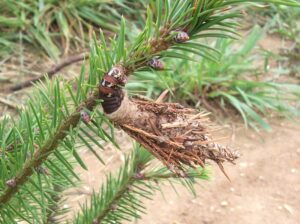
Late instar bagworm caterpillar feeding on a Douglas-fir tree. Research shows that stressed conifers will have a more difficult time dealing with insect/mites than deciduous trees. (Photo Credit: Steven K, Rettke, Rutgers Coop. Ext.)
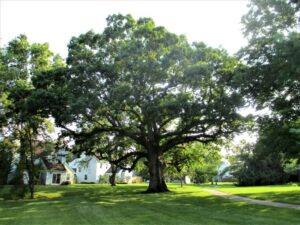
Mature trees under stress, such as this large white oak will withstand insect attacks better than younger trees under stress, but not when infested by wood borers. (Photo Credit: Steven K. Rettke, Rutgers Coop. Ext.)
Who are the big winners and losers? Suckers and borers usually benefit when plants are stressed. Chewers and miners show no consistent response when plants are stressed. For example, it is not correct to state that gypsy moths will do better when oaks are under drought stress. Gallers will trend to suffer when plants are stressed.
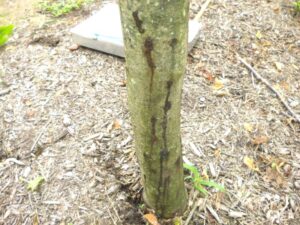
The trunk of this magnolia tree shows symptoms & signs from ambrosia beetle borers. This tree was stressed from excessive soil moisture which caused the release of ethanol from the stressed tree that attracted the borers. (Photo Credit: Steven K. Rettke, Rutgers Coop. Ext.)
Reference: “Insect Performance on Experimentally Stressed Woody Plants: A Meta-Analysis,” 1998, Julia Koricheva & Stig Larsson, Department of Entomology, Swedish University of Agricultural Sciences.
Reference: Adapted from a presentation by Dr. Mike Raupp, Department of Entomology, University of Maryland. Delivered during the American Society of Consulting Arborists Conference, @ Newport, RI, 12/5/2000.

